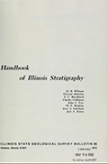Historical:Drummond Member
Lithostratigraphy: Hunton Limestone Megagroup >>Kankakee Formation >>Drummond Member
Chronostratigraphy: Paleozoic Erathem >>Silurian System >>Alexandrian Series
Allostratigraphy: Tippecanoe Sequence
Authors
H. B. Willman and Elwood Atherton
Name Origin
The Drummond Member of the Kankakee Formation (Willman, 1973, p. 17), the basal member, is named for Drummond, Will County, 5.5 miles southwest of the type section.
Type Section
The type section of the Drummond Member is located in a railroad cut on the southeast side of the Des Plaines River Valley, 2 miles southwest of Joliet, Will County (NW SE SW 30, 35N-10E), where the member is 8.5 feet thick.
Extent and Thickness
The Drummond Member is as much as 11 feet thick in the Joliet area but thins to only 1 foot thick along the Kankakee River.
Description
The Drummond Member is pure, vesicular to coarsely vuggy, gray dolomite that generally contains abundant grains of glauconite, scattered grains of well rounded quartz sand, relatively large chert nodules, and large colonies of corals.
Fossils
The Platymerella Zone occurs in the lower part of the Drummond Member, with the fossils most common in lenses of chert.
References
WILLMAN, H. B., 1973, Rock stratigraphy of the Silurian System in northeastern and northwestern Illinois: Illinois State Geological Survey Circular 479, 55 p.
ISGS Codes
| Stratigraphic Code | Geo Unit Designation |
|---|---|
